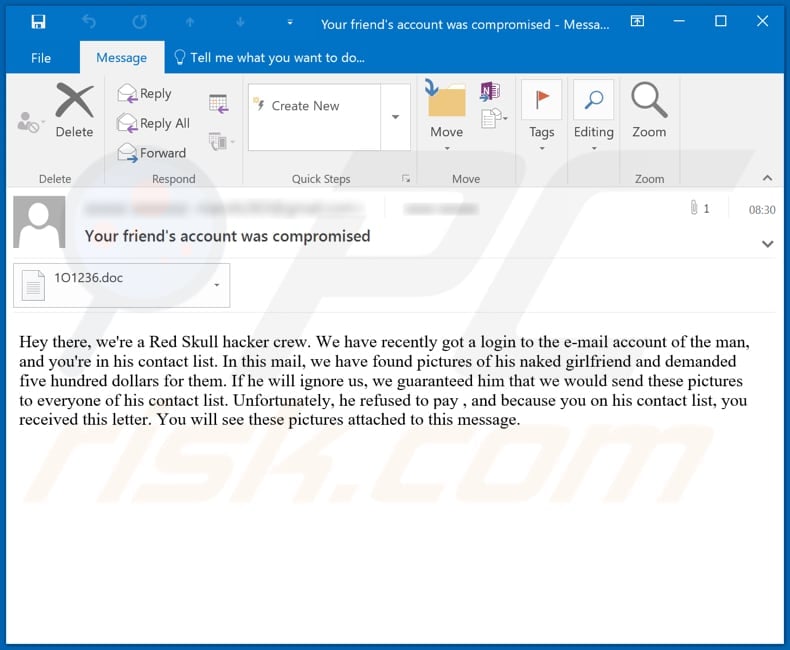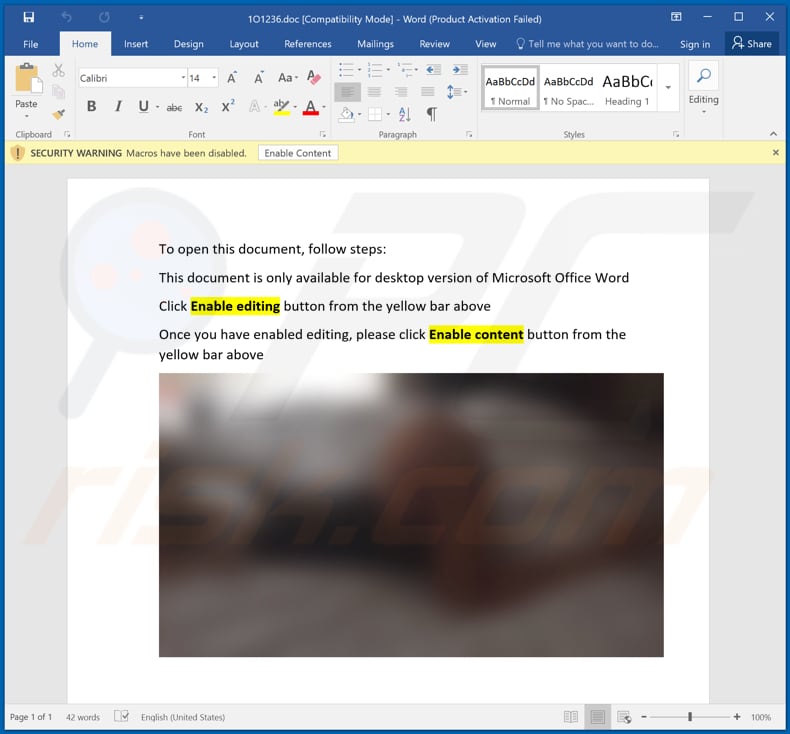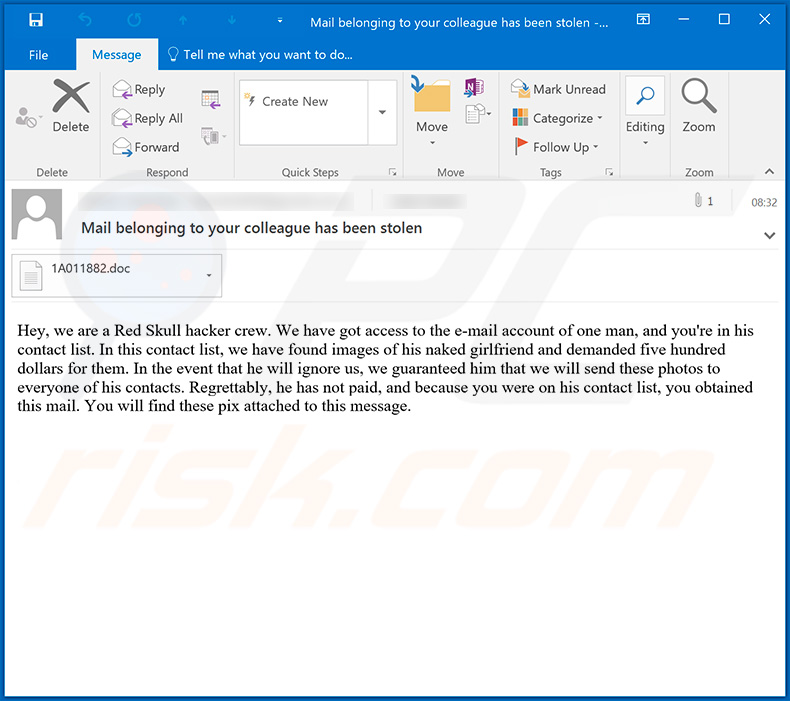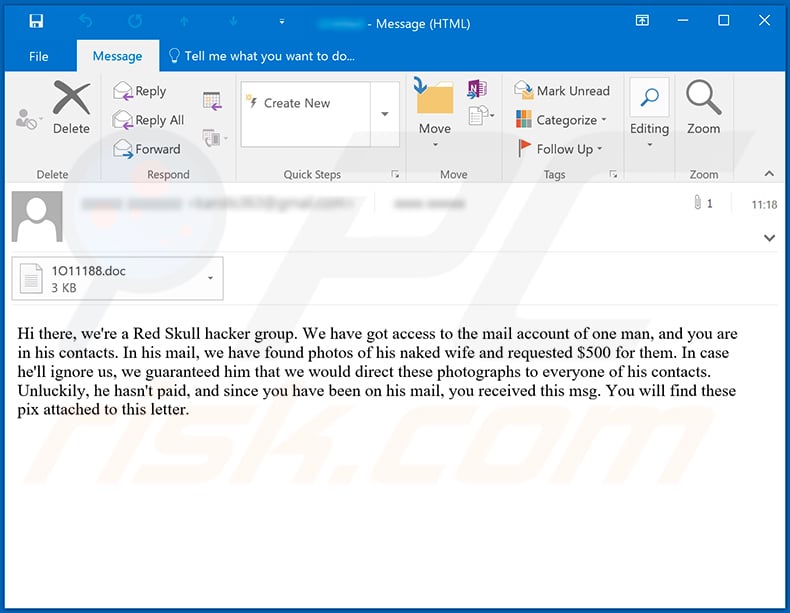Do not open the contents of "Your friend’s account was compromised" email
Phishing/ScamAlso Known As: Your Friend’s Account Was Compromised spam
Get free scan and check if your device is infected.
Remove it nowTo use full-featured product, you have to purchase a license for Combo Cleaner. Seven days free trial available. Combo Cleaner is owned and operated by RCS LT, the parent company of PCRisk.com.
What is "Your friend’s account was compromised Email Virus"?
There are many examples of spam campaigns used by cyber criminals to infect computers with malicious programs. Typically, they send emails that contain dangerous attachments or website links hoping that recipients will open them. Their main goal is to trick people into executing a malicious file, which infects operating systems with malware.
This particular spam campaign is used to trick recipients into installing Raccoon Stealer. Therefore, we strongly advise against trusting this email - leave its contents unopened.

Scammers claim that they have hacked the email account of a person and subsequently found photos of his naked girlfriend. They apparently asked him to pay $500 for not distributing the photos, but the person refused to pay and now scammers offer recipients of the email to see the photos through the attached .doc (Microsoft Office) file.
To see the photos, recipients must supposedly open the document and grant permission for it to enable editing/content. This document actually installs RacoonStealer. By enabling content/editing, recipients would allow the document to cause installation of this rogue software.
Racoon Stealer is a malicious program that steals various personal, sensitive information such as passwords, browser cookies, auto-fill data and cryptowallet details. Typically, cyber criminals use this information to make fraudulent purchases and transactions, steal identities, and so on.
They also misuse hijacked accounts to proliferate other spam campaigns (including this one), trick other people into transferring money, and so on. These problems can be avoided by leaving the contents of this spam campaign (email) unopened.
| Name | Your Friend’s Account Was Compromised spam |
| Threat Type | Trojan, password-stealing virus, banking malware, spyware. |
| Attachment(s) | 1O1236.doc (its name might vary). |
| Detection Names (1O1236.doc) | Cyren (W97M/Downldr.KQ.gen!Eldorado), DrWeb (Trojan.Siggen9.17251), ESET-NOD32 (GenScript.IGH), Kaspersky (HEUR:Trojan.MSOffice.SAgent.gen), Full List Of Detections (VirusTotal) |
| Detection Names (AutoIt3.exe/Racoon Stealer's executable) | Jiangmin (Trojan.Miner.ffr), SecureAge APEX (Malicious), Webroot (Pua.Riskware.Autoit), Zoner (Trojan.Win32.87659), Full List (VirusTotal) |
| Symptoms | Trojans are designed to stealthily infiltrate the victim's computer and remain silent, and thus no particular symptoms are clearly visible on an infected machine. |
| Payload | Racoon Stealer, Ursnif |
| Distribution methods | Infected email attachments, malicious online advertisements, social engineering, software 'cracks'. |
| Damage | Stolen passwords and banking information, identity theft, the victim's computer added to a botnet. |
| Malware Removal (Windows) |
To eliminate possible malware infections, scan your computer with legitimate antivirus software. Our security researchers recommend using Combo Cleaner. Download Combo CleanerTo use full-featured product, you have to purchase a license for Combo Cleaner. 7 days free trial available. Combo Cleaner is owned and operated by RCS LT, the parent company of PCRisk.com. |
Other examples of spam campaigns used to trick recipients into installing malicious software on their computers include "Secret Love Email Virus", "PETRONAS Email Virus" and "WeTransfer Email Virus". Examples of malicious programs that are distributed in this way are Emotet, TrickBot, Adwind and LokiBot.
In most cases, attached files, or files downloaded through included website links, lead to installation of software that can steal personal information, encrypt data, proliferate other malware and perform other actions leading to serious problems.
How did "Your friend’s account was compromised Email Virus" infect my computer?
Racoon Stealer is installed only if recipients enable editing/content of a malicious document, which is attached to the received email. Therefore, computers are safe as long as the malicious Microsoft Office document remains unopened.
More examples of files that cyber criminals attach to their emails are PDF documents, archive files such as ZIP, RAR, executable files such as .exe and JavaScript files. Note that cyber criminals who attempt to proliferate malware through emails (spam campaigns) disguise their emails as important and official.
How to avoid installation of malware
Do not open files or website links in irrelevant emails that are received from unknown, suspicious addresses. All software should be downloaded from official websites and via direct links. Other sources, tools such as third party downloaders, installers, unofficial pages, Peer-to-Peer networks (e.g., torrent clients, eMule), etc. are often used to distribute malicious software.
Therefore, they should not be used to download or install software. Furthermore, software must be updated and activated only through implemented tools or functions that are designed by official developers. It is illegal to activate licensed programs with unofficial activation ('cracking') tools.
Furthermore, these tools often cause installation of malware.
Regularly scan the operating system for threats with reputable antivirus or anti-spyware software and keep it up to date. If you have already opened "Your friend’s account was compromised Email Virus" attachment, we recommend running a scan with Combo Cleaner Antivirus for Windows to automatically eliminate infiltrated malware.
Text presented in the "Your friend’s account was compromised" email message:
Subject: Your friend's account was compromised
Hey there, we're a Red Skull hacker crew. We have recently got a login to the e-mail account of the man, and you're in his contact list. In this mail, we have found pictures of his naked girlfriend and demanded five hundred dollars for them. If he will ignore us, we guaranteed him that we would send these pictures to everyone of his contact list. Unfortunately, he refused to pay , and because you on his contact list, you received this letter. You will see these pictures attached to this message.
Malicious attachment distributed via the "Your friend’s account was compromised" spam campaign:

Text in this document:
To open this document, follow steps:
This document is only available for desktop version of Microsoft Office Word
Click Enable editing button from the yellow bar above
Once you have enabled editing, please click Enable content button from the yellow bar above
Another variant of "Your friend’s account was compromised" spam campaign distributing Ursnif trojan:

Text presented within this email:
Subject: Mail belonging to your colleague has been stolen
Hey, we are a Red Skull hacker crew. We have got access to the e-mail account of one man, and you're in his contact list. In this contact list, we have found images of his naked girlfriend and demanded five hundred dollars for them. In the event that he will ignore us, we guaranteed him that we will send these photos to everyone of his contacts. Regrettably, he has not paid, and because you were on his contact list, you obtained this mail. You will find these pix attached to this message.
Another "Your Friend’s Account Was Compromised" spam email used to spread Raccoon Stealer malware:

Text presented within this email:
Hi there, we're a Red Skull hacker group. We have got access to the mail account of one man, and you are in his contacts. In his mail, we have found photos of his naked wife and requested $500 for them. In case he'll ignore us, we guaranteed him that we would direct these photographs to everyone of his contacts. Unluckily, he hasn't paid, and since you have been on his mail, you received this msg. You will find these pix attached to this letter.
Instant automatic malware removal:
Manual threat removal might be a lengthy and complicated process that requires advanced IT skills. Combo Cleaner is a professional automatic malware removal tool that is recommended to get rid of malware. Download it by clicking the button below:
DOWNLOAD Combo CleanerBy downloading any software listed on this website you agree to our Privacy Policy and Terms of Use. To use full-featured product, you have to purchase a license for Combo Cleaner. 7 days free trial available. Combo Cleaner is owned and operated by RCS LT, the parent company of PCRisk.com.
Quick menu:
- What is Your Friend’s Account Was Compromised spam?
- Types of malicious emails.
- How to spot a malicious email?
- What to do if you fell for an email scam?
Types of malicious emails:
![]() Phishing Emails
Phishing Emails
Most commonly, cybercriminals use deceptive emails to trick Internet users into giving away their sensitive private information, for example, login information for various online services, email accounts, or online banking information.
Such attacks are called phishing. In a phishing attack, cybercriminals usually send an email message with some popular service logo (for example, Microsoft, DHL, Amazon, Netflix), create urgency (wrong shipping address, expired password, etc.), and place a link which they hope their potential victims will click on.
After clicking the link presented in such email message, victims are redirected to a fake website that looks identical or extremely similar to the original one. Victims are then asked to enter their password, credit card details, or some other information that gets stolen by cybercriminals.
![]() Emails with Malicious Attachments
Emails with Malicious Attachments
Another popular attack vector is email spam with malicious attachments that infect users' computers with malware. Malicious attachments usually carry trojans that are capable of stealing passwords, banking information, and other sensitive information.
In such attacks, cybercriminals' main goal is to trick their potential victims into opening an infected email attachment. To achieve this goal, email messages usually talk about recently received invoices, faxes, or voice messages.
If a potential victim falls for the lure and opens the attachment, their computers get infected, and cybercriminals can collect a lot of sensitive information.
While it's a more complicated method to steal personal information (spam filters and antivirus programs usually detect such attempts), if successful, cybercriminals can get a much wider array of data and can collect information for a long period of time.
![]() Sextortion Emails
Sextortion Emails
This is a type of phishing. In this case, users receive an email claiming that a cybercriminal could access the webcam of the potential victim and has a video recording of one's masturbation.
To get rid of the video, victims are asked to pay a ransom (usually using Bitcoin or another cryptocurrency). Nevertheless, all of these claims are false - users who receive such emails should ignore and delete them.
How to spot a malicious email?
While cyber criminals try to make their lure emails look trustworthy, here are some things that you should look for when trying to spot a phishing email:
- Check the sender's ("from") email address: Hover your mouse over the "from" address and check if it's legitimate. For example, if you received an email from Microsoft, be sure to check if the email address is @microsoft.com and not something suspicious like @m1crosoft.com, @microsfot.com, @account-security-noreply.com, etc.
- Check for generic greetings: If the greeting in the email is "Dear user", "Dear @youremail.com", "Dear valued customer", this should raise suspiciousness. Most commonly, companies call you by your name. Lack of this information could signal a phishing attempt.
- Check the links in the email: Hover your mouse over the link presented in the email, if the link that appears seems suspicious, don't click it. For example, if you received an email from Microsoft and the link in the email shows that it will go to firebasestorage.googleapis.com/v0... you shouldn't trust it. It's best not to click any links in the emails but to visit the company website that sent you the email in the first place.
- Don't blindly trust email attachments: Most commonly, legitimate companies will ask you to log in to their website and to view any documents there; if you received an email with an attachment, it's a good idea to scan it with an antivirus application. Infected email attachments are a common attack vector used by cybercriminals.
To minimise the risk of opening phishing and malicious emails we recommend using Combo Cleaner Antivirus for Windows.
Example of a spam email:

What to do if you fell for an email scam?
- If you clicked on a link in a phishing email and entered your password - be sure to change your password as soon as possible. Usually, cybercriminals collect stolen credentials and then sell them to other groups that use them for malicious purposes. If you change your password in a timely manner, there's a chance that criminals won't have enough time to do any damage.
- If you entered your credit card information - contact your bank as soon as possible and explain the situation. There's a good chance that you will need to cancel your compromised credit card and get a new one.
- If you see any signs of identity theft - you should immediately contact the Federal Trade Commission. This institution will collect information about your situation and create a personal recovery plan.
- If you opened a malicious attachment - your computer is probably infected, you should scan it with a reputable antivirus application. For this purpose, we recommend using Combo Cleaner Antivirus for Windows.
- Help other Internet users - report phishing emails to Anti-Phishing Working Group, FBI’s Internet Crime Complaint Center, National Fraud Information Center and U.S. Department of Justice.
Share:

Tomas Meskauskas
Expert security researcher, professional malware analyst
I am passionate about computer security and technology. I have an experience of over 10 years working in various companies related to computer technical issue solving and Internet security. I have been working as an author and editor for pcrisk.com since 2010. Follow me on Twitter and LinkedIn to stay informed about the latest online security threats.
PCrisk security portal is brought by a company RCS LT.
Joined forces of security researchers help educate computer users about the latest online security threats. More information about the company RCS LT.
Our malware removal guides are free. However, if you want to support us you can send us a donation.
DonatePCrisk security portal is brought by a company RCS LT.
Joined forces of security researchers help educate computer users about the latest online security threats. More information about the company RCS LT.
Our malware removal guides are free. However, if you want to support us you can send us a donation.
Donate
▼ Show Discussion